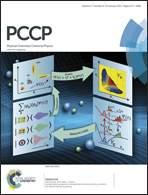A femtosecond study of the anomaly in electron injection for dye-sensitized solar cells: the influence of isomerization employing Ru(ii) sensitizers with anthracene and phenanthrene ancillary ligands†
Abstract
In this study, an intriguing difference caused by structural isomerization based on anthracene and phenanthrene stilbazole type ancillary ligands in Ru(II) sensitizers for dye sensitized solar cells (DSCs) has been investigated using femtosecond transient absorption spectroscopy. Both anthracene and phenanthrene based sensitizers HD-7 and HD-8, respectively, resulted in a similar extinction coefficient, photophysical and thermodynamic free energy of electron injection and dye regeneration as measured by UV-Vis, excited state lifetime and cyclic voltammetry measurements, respectively. However, TiO2 adsorbed HD-7 resulted in up to 45% less photocurrent density than HD-8 although photovoltage was similar owing to comparable thermodynamic characteristics. It was obvious from the measurement of incident photon to current conversion efficiency (IPCE) that excited electrons in HD-7 are prone to internal energy loss before injection into the TiO2 conduction band. Analysis of photo-induced spectral features measured by femtosecond transient absorption spectroscopy showed that excited electrons in HD-7 are prone to ISC (intersystem crossing) much more than HD-8 and those triplet electrons are not injected into TiO2 efficiently. Interestingly, from impedance measurements, HD-7 showed higher recombination resistance than HD-8 and N719, but a shorter lifetime for electrons injected into the TiO2 conduction band.


 Please wait while we load your content...
Please wait while we load your content...